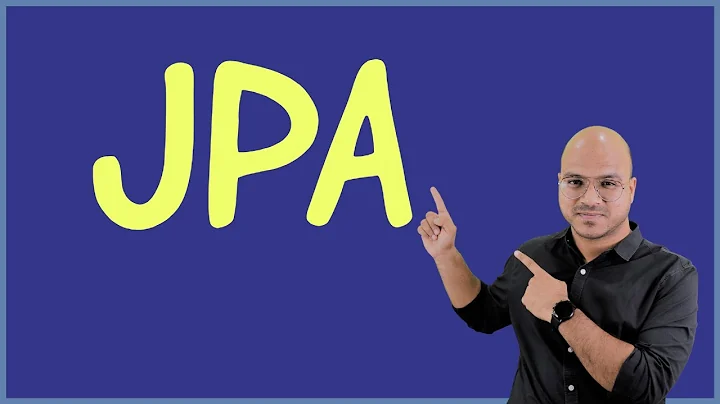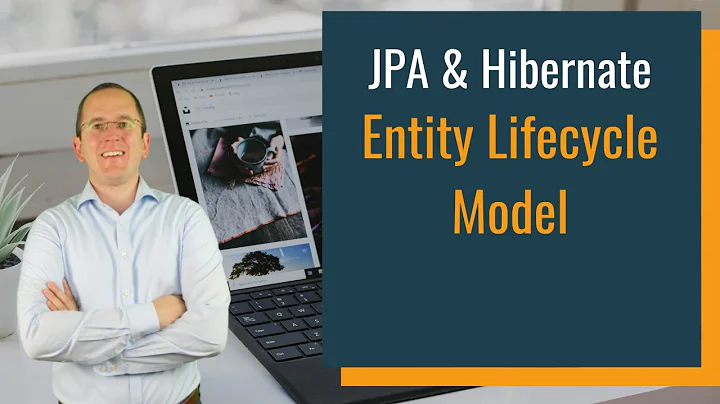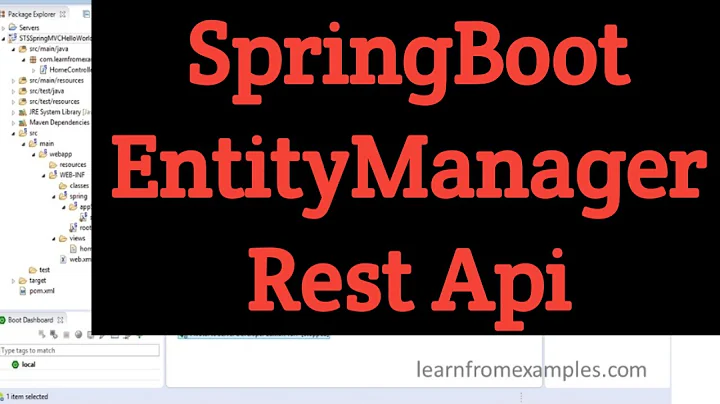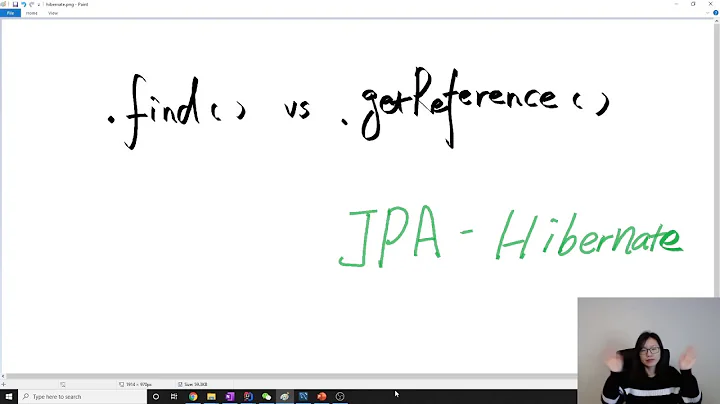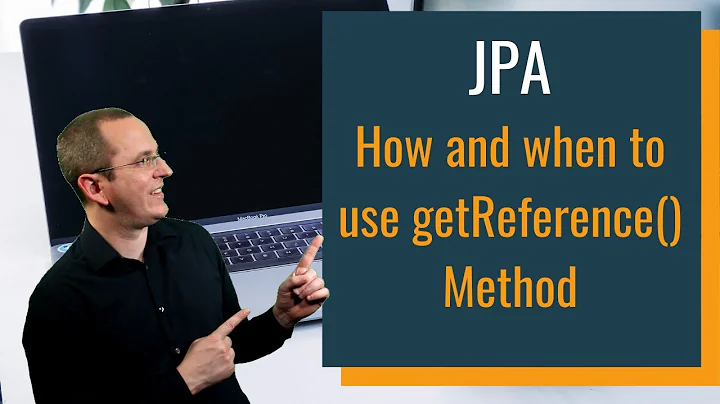When to use EntityManager.find() vs EntityManager.getReference() with JPA
Solution 1
I usually use getReference method when i do not need to access database state (I mean getter method). Just to change state (I mean setter method). As you should know, getReference returns a proxy object which uses a powerful feature called automatic dirty checking. Suppose the following
public class Person {
private String name;
private Integer age;
}
public class PersonServiceImpl implements PersonService {
public void changeAge(Integer personId, Integer newAge) {
Person person = em.getReference(Person.class, personId);
// person is a proxy
person.setAge(newAge);
}
}
If i call find method, JPA provider, behind the scenes, will call
SELECT NAME, AGE FROM PERSON WHERE PERSON_ID = ?
UPDATE PERSON SET AGE = ? WHERE PERSON_ID = ?
If i call getReference method, JPA provider, behind the scenes, will call
UPDATE PERSON SET AGE = ? WHERE PERSON_ID = ?
And you know why ???
When you call getReference, you will get a proxy object. Something like this one (JPA provider takes care of implementing this proxy)
public class PersonProxy {
// JPA provider sets up this field when you call getReference
private Integer personId;
private String query = "UPDATE PERSON SET ";
private boolean stateChanged = false;
public void setAge(Integer newAge) {
stateChanged = true;
query += query + "AGE = " + newAge;
}
}
So before transaction commit, JPA provider will see stateChanged flag in order to update OR NOT person entity. If no rows is updated after update statement, JPA provider will throw EntityNotFoundException according to JPA specification.
regards,
Solution 2
Assuming you have a parent Post entity and a child PostComment as illustrated in the following diagram:
If you call find when you try to set the @ManyToOne post association:
PostComment comment = new PostComment();
comment.setReview("Just awesome!");
Post post = entityManager.find(Post.class, 1L);
comment.setPost(post);
entityManager.persist(comment);
Hibernate will execute the following statements:
SELECT p.id AS id1_0_0_,
p.title AS title2_0_0_
FROM post p
WHERE p.id = 1
INSERT INTO post_comment (post_id, review, id)
VALUES (1, 'Just awesome!', 1)
The SELECT query is useless this time because we don’t need the Post entity to be fetched. We only want to set the underlying post_id Foreign Key column.
Now, if you use getReference instead:
PostComment comment = new PostComment();
comment.setReview("Just awesome!");
Post post = entityManager.getReference(Post.class, 1L);
comment.setPost(post);
entityManager.persist(comment);
This time, Hibernate will issue just the INSERT statement:
INSERT INTO post_comment (post_id, review, id)
VALUES (1, 'Just awesome!', 1)
Unlike find, the getReference only returns an entity Proxy which only has the identifier set. If you access the Proxy, the associated SQL statement will be triggered as long as the EntityManager is still open.
However, in this case, we don’t need to access the entity Proxy. We only want to propagate the Foreign Key to the underlying table record so loading a Proxy is sufficient for this use case.
When loading a Proxy, you need to be aware that a LazyInitializationException can be thrown if you try to access the Proxy reference after the EntityManager is closed.
Solution 3
This makes me wonder, when is it advisable to use the EntityManager.getReference() method instead of the EntityManager.find() method?
EntityManager.getReference() is really an error prone method and there is really very few cases where a client code needs to use it.
Personally, I never needed to use it.
EntityManager.getReference() and EntityManager.find() : no difference in terms of overhead
I disagree with the accepted answer and particularly :
If i call find method, JPA provider, behind the scenes, will call
SELECT NAME, AGE FROM PERSON WHERE PERSON_ID = ? UPDATE PERSON SET AGE = ? WHERE PERSON_ID = ?If i call getReference method, JPA provider, behind the scenes, will call
UPDATE PERSON SET AGE = ? WHERE PERSON_ID = ?
It is not the behavior that I get with Hibernate 5 and the javadoc of getReference() doesn't say such a thing :
Get an instance, whose state may be lazily fetched. If the requested instance does not exist in the database, the EntityNotFoundException is thrown when the instance state is first accessed. (The persistence provider runtime is permitted to throw the EntityNotFoundException when getReference is called.) The application should not expect that the instance state will be available upon detachment, unless it was accessed by the application while the entity manager was open.
EntityManager.getReference() spares a query to retrieve the entity in two cases :
1) if the entity is stored in the Persistence context, that is
the first level cache.
And this behavior is not specific to EntityManager.getReference(),
EntityManager.find() will also spare a query to retrieve the entity if the entity is stored in the Persistence context.
You can check the first point with any example.
You can also rely on the actual Hibernate implementation.
Indeed, EntityManager.getReference() relies on the createProxyIfNecessary() method of the org.hibernate.event.internal.DefaultLoadEventListener class to load the entity.
Here is its implementation :
private Object createProxyIfNecessary(
final LoadEvent event,
final EntityPersister persister,
final EntityKey keyToLoad,
final LoadEventListener.LoadType options,
final PersistenceContext persistenceContext) {
Object existing = persistenceContext.getEntity( keyToLoad );
if ( existing != null ) {
// return existing object or initialized proxy (unless deleted)
if ( traceEnabled ) {
LOG.trace( "Entity found in session cache" );
}
if ( options.isCheckDeleted() ) {
EntityEntry entry = persistenceContext.getEntry( existing );
Status status = entry.getStatus();
if ( status == Status.DELETED || status == Status.GONE ) {
return null;
}
}
return existing;
}
if ( traceEnabled ) {
LOG.trace( "Creating new proxy for entity" );
}
// return new uninitialized proxy
Object proxy = persister.createProxy( event.getEntityId(), event.getSession() );
persistenceContext.getBatchFetchQueue().addBatchLoadableEntityKey( keyToLoad );
persistenceContext.addProxy( keyToLoad, proxy );
return proxy;
}
The interesting part is :
Object existing = persistenceContext.getEntity( keyToLoad );
2) If we don't effectively manipulate the entity, echoing to the lazily fetched of the javadoc.
Indeed, to ensure the effective loading of the entity, invoking a method on it is required.
So the gain would be related to a scenario where we want to load a entity without having the need to use it ? In the frame of applications, this need is really uncommon and in addition the getReference() behavior is also very misleading if you read the next part.
Why favor EntityManager.find() over EntityManager.getReference()
In terms of overhead, getReference() is not better than find() as discussed in the previous point.
So why use the one or the other ?
Invoking getReference() may return a lazily fetched entity.
Here, the lazy fetching doesn't refer to relationships of the entity but the entity itself.
It means that if we invoke getReference() and then the Persistence context is closed, the entity may be never loaded and so the result is really unpredictable. For example if the proxy object is serialized, you could get a null reference as serialized result or if a method is invoked on the proxy object, an exception such as LazyInitializationException is thrown.
It means that the throw of EntityNotFoundException that is the main reason to use getReference() to handle an instance that does not exist in the database as an error situation may be never performed while the entity is not existing.
EntityManager.find() doesn't have the ambition of throwing EntityNotFoundException if the entity is not found. Its behavior is both simple and clear. You will never have surprise as it returns always a loaded entity or null (if the entity is not found) but never an entity under the shape of a proxy that may not be effectively loaded.
So EntityManager.find() should be favored in the very most of cases.
Solution 4
Because a reference is 'managed', but not hydrated, it can also allow you to remove an entity by ID, without needing to load it into memory first.
As you can't remove an unmanaged entity, it's just plain silly to load all fields using find(...) or createQuery(...), only to immediately delete it.
MyLargeObject myObject = em.getReference(MyLargeObject.class, objectId);
em.remove(myObject);
Solution 5
I disagree with the selected answer, and as davidxxx correctly pointed out, getReference does not provide such behaviour of dynamic updations without select. I asked a question concerning the validity of this answer, see here - cannot update without issuing select on using setter after getReference() of hibernate JPA.
I quite honestly haven't seen anybody who's actually used that functionality. ANYWHERE. And i don't understand why it's so upvoted.
Now first of all, no matter what you call on a hibernate proxy object, a setter or a getter, an SQL is fired and the object is loaded.
But then i thought, so what if JPA getReference() proxy doesn't provide that functionality. I can just write my own proxy.
Now, we can all argue that selects on primary keys are as fast as a query can get and it's not really something to go to great lengths to avoid. But for those of us who can't handle it due to one reason or another, below is an implementation of such a proxy. But before i you see the implementation, see it's usage and how simple it is to use.
USAGE
Order example = ProxyHandler.getReference(Order.class, 3);
example.setType("ABCD");
example.setCost(10);
PersistenceService.save(example);
And this would fire the following query -
UPDATE Order SET type = 'ABCD' and cost = 10 WHERE id = 3;
and even if you want to insert, you can still do PersistenceService.save(new Order("a", 2)); and it would fire an insert as it should.
IMPLEMENTATION
Add this to your pom.xml -
<dependency>
<groupId>cglib</groupId>
<artifactId>cglib</artifactId>
<version>3.2.10</version>
</dependency>
Make this class to create dynamic proxy -
@SuppressWarnings("unchecked")
public class ProxyHandler {
public static <T> T getReference(Class<T> classType, Object id) {
if (!classType.isAnnotationPresent(Entity.class)) {
throw new ProxyInstantiationException("This is not an entity!");
}
try {
Enhancer enhancer = new Enhancer();
enhancer.setSuperclass(classType);
enhancer.setCallback(new ProxyMethodInterceptor(classType, id));
enhancer.setInterfaces((new Class<?>[]{EnhancedProxy.class}));
return (T) enhancer.create();
} catch (Exception e) {
throw new ProxyInstantiationException("Error creating proxy, cause :" + e.getCause());
}
}
Make an interface with all the methods -
public interface EnhancedProxy {
public String getJPQLUpdate();
public HashMap<String, Object> getModifiedFields();
}
Now, make an interceptor which will allow you to implement these methods on your proxy -
import com.anil.app.exception.ProxyInstantiationException;
import javafx.util.Pair;
import net.sf.cglib.proxy.MethodInterceptor;
import net.sf.cglib.proxy.MethodProxy;
import javax.persistence.Id;
import java.lang.reflect.Field;
import java.lang.reflect.Method;
import java.util.*;
/**
* @author Anil Kumar
*/
public class ProxyMethodInterceptor implements MethodInterceptor, EnhancedProxy {
private Object target;
private Object proxy;
private Class classType;
private Pair<String, Object> primaryKey;
private static HashSet<String> enhancedMethods;
ProxyMethodInterceptor(Class classType, Object id) throws IllegalAccessException, InstantiationException {
this.classType = classType;
this.target = classType.newInstance();
this.primaryKey = new Pair<>(getPrimaryKeyField().getName(), id);
}
static {
enhancedMethods = new HashSet<>();
for (Method method : EnhancedProxy.class.getDeclaredMethods()) {
enhancedMethods.add(method.getName());
}
}
@Override
public Object intercept(Object obj, Method method, Object[] args, MethodProxy proxy) throws Throwable {
//intercept enhanced methods
if (enhancedMethods.contains(method.getName())) {
this.proxy = obj;
return method.invoke(this, args);
}
//else invoke super class method
else
return proxy.invokeSuper(obj, args);
}
@Override
public HashMap<String, Object> getModifiedFields() {
HashMap<String, Object> modifiedFields = new HashMap<>();
try {
for (Field field : classType.getDeclaredFields()) {
field.setAccessible(true);
Object initialValue = field.get(target);
Object finalValue = field.get(proxy);
//put if modified
if (!Objects.equals(initialValue, finalValue)) {
modifiedFields.put(field.getName(), finalValue);
}
}
} catch (Exception e) {
return null;
}
return modifiedFields;
}
@Override
public String getJPQLUpdate() {
HashMap<String, Object> modifiedFields = getModifiedFields();
if (modifiedFields == null || modifiedFields.isEmpty()) {
return null;
}
StringBuilder fieldsToSet = new StringBuilder();
for (String field : modifiedFields.keySet()) {
fieldsToSet.append(field).append(" = :").append(field).append(" and ");
}
fieldsToSet.setLength(fieldsToSet.length() - 4);
return "UPDATE "
+ classType.getSimpleName()
+ " SET "
+ fieldsToSet
+ "WHERE "
+ primaryKey.getKey() + " = " + primaryKey.getValue();
}
private Field getPrimaryKeyField() throws ProxyInstantiationException {
for (Field field : classType.getDeclaredFields()) {
field.setAccessible(true);
if (field.isAnnotationPresent(Id.class))
return field;
}
throw new ProxyInstantiationException("Entity class doesn't have a primary key!");
}
}
And the exception class -
public class ProxyInstantiationException extends RuntimeException {
public ProxyInstantiationException(String message) {
super(message);
}
A service to save using this proxy -
@Service
public class PersistenceService {
@PersistenceContext
private EntityManager em;
@Transactional
private void save(Object entity) {
// update entity for proxies
if (entity instanceof EnhancedProxy) {
EnhancedProxy proxy = (EnhancedProxy) entity;
Query updateQuery = em.createQuery(proxy.getJPQLUpdate());
for (Entry<String, Object> entry : proxy.getModifiedFields().entrySet()) {
updateQuery.setParameter(entry.getKey(), entry.getValue());
}
updateQuery.executeUpdate();
// insert otherwise
} else {
em.persist(entity);
}
}
}
Related videos on Youtube
SibzTer
A newbie wading into the shallow end of the big blue bottomless pool of Java and JEE. Starting to make the first strokes and getting ready to dive deeper in.
Updated on July 08, 2022Comments
-
SibzTer almost 2 years
I have come across a situation (which I think is weird but is possibly quite normal) where I use the EntityManager.getReference(LObj.getClass(), LObj.getId()) to get a database entity and then pass the returned object to be persisted in another table.
So basically the flow was like this:
class TFacade{ createT(FObj, AObj) { T TObj = new T(); TObj.setF(FObj); TObj.setA(AObj); ... EntityManager.persist(TObj); ... L LObj = A.getL(); FObj.setL(LObj); FFacade.editF(FObj); } } @TransactionAttributeType.REQUIRES_NEW class FFacade{ editF(FObj){ L LObj = FObj.getL(); LObj = EntityManager.getReference(LObj.getClass(), LObj.getId()); ... EntityManager.merge(FObj); ... FLHFacade.create(FObj, LObj); } } @TransactionAttributeType.REQUIRED class FLHFacade{ createFLH(FObj, LObj){ FLH FLHObj = new FLH(); FLHObj.setF(FObj); FLHObj.setL(LObj); .... EntityManager.persist(FLHObj); ... } }I was getting the following exception "java.lang.IllegalArgumentException: Unknown entity: com.my.persistence.L$$EnhancerByCGLIB$$3e7987d0"
After looking into it for a while, I finally figured out that it was because I was using the EntityManager.getReference() method that I was getting the above exception as the method was returning a proxy.
This makes me wonder, when is it advisable to use the EntityManager.getReference() method instead of the EntityManager.find() method?
EntityManager.getReference() throws an EntityNotFoundException if it cant find the entity being searched for which is very convenient in itself. EntityManager.find() method merely returns null if it cant find the entity.
With regards to transaction boundaries, sounds to me like you would need to use the find() method before passing the newly found entity to a new transaction. If you use the getReference() method then you would probably end up in a situation similar to mine with the above exception.
-
SibzTer over 14 yearsForgot to mention, I am using Hibernate as the JPA provider.
-
-
 Dejan Milosevic over 10 yearsI'm using EclipseLink 2.5.0 and the queries stated above are not correct. It always issues a
Dejan Milosevic over 10 yearsI'm using EclipseLink 2.5.0 and the queries stated above are not correct. It always issues aSELECTbeforeUPDATE, no matter which offind()/getReference()I use. What is worse,SELECTtraverses NON-LAZY relations (issuing newSELECTS), although I just want to update a single field in one entity. -
 David Hofmann about 8 years@Arthur Ronald what happens if there is a Version annotation in the entity called by getReference?
David Hofmann about 8 years@Arthur Ronald what happens if there is a Version annotation in the entity called by getReference? -
Stéphane Appercel almost 7 yearsI have the same issue as @DejanMilosevic: when removing an entity obtained via getReference(), a SELECT is issued on that entity and it traverses all the LAZY relations of that entity, thus issuing many SELECTS (with EclipseLink 2.5.0).
-
 Adrian almost 6 yearsThank you Vlad for letting us to know this! But according to javadoc this seems disturbing: "The persistence provider runtime is permitted to throw the EntityNotFoundException when getReference is called". This is not possible without a SELECT (at least for checking the row existence), is it? So an eventually SELECT depends on the implementation.
Adrian almost 6 yearsThank you Vlad for letting us to know this! But according to javadoc this seems disturbing: "The persistence provider runtime is permitted to throw the EntityNotFoundException when getReference is called". This is not possible without a SELECT (at least for checking the row existence), is it? So an eventually SELECT depends on the implementation. -
 Adrian almost 6 yearsYour reason is misleading when compared with the accepted response + Vlad Mihalcea response + my comment to Vlad Mihalcea (maybe a less important this last +).
Adrian almost 6 yearsYour reason is misleading when compared with the accepted response + Vlad Mihalcea response + my comment to Vlad Mihalcea (maybe a less important this last +). -
 Vlad Mihalcea almost 6 yearsFor the use case that you described, Hibernate offers the
Vlad Mihalcea almost 6 yearsFor the use case that you described, Hibernate offers thehibernate.jpa.compliance.proxyconfiguration property, so you can choose either JPA compliance or better data access performance. -
JL_SO over 5 yearsPro JPA2 does state: "Given the very specific situation in which getReference() can be used, find() should be used in virtually all cases".
-
 rilaby over 4 years@VladMihalcea why
rilaby over 4 years@VladMihalcea whygetReferenceis needed at all if it is just enough to set new instance of model with PK set. What am I missing? -
 Vlad Mihalcea over 4 yearsThis is only supported in Hibernarea will not allow you to load the association if traversed.
Vlad Mihalcea over 4 yearsThis is only supported in Hibernarea will not allow you to load the association if traversed. -
João Fé almost 4 yearsUpvote this question because it's a necessary complement to the accepted answer and because my tests showed that, when setting a property of the entity proxy, it's fetched from the database, contrary to what the accepted answer says. Only the case stated by Vlad passed my tests.
-
Moritz Becker about 2 years@VladMihalcea Your last comment seems incomplete/broken, could you correct it please?
-
 Vlad Mihalcea about 2 years@rilaby Setting a Proxy allows you to initialize it later. Setting an empty POJO that only has an id is a hack, that happens to work in Hibernate. But, later, you can end up querying non-id properties and get
Vlad Mihalcea about 2 years@rilaby Setting a Proxy allows you to initialize it later. Setting an empty POJO that only has an id is a hack, that happens to work in Hibernate. But, later, you can end up querying non-id properties and getnullinstead of the actual property value. -
Eric P about 2 yearsVery late to the party, but yup: as soon as you try to access anything other than the id of the entity it will be fetched. Getting the reference alone will not make a select but calling setAge() will.

